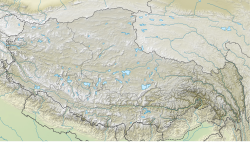Zhêntang
Zhêntang
འདྲེན་ཐང་གྲོང་བརྡལ · 陈塘镇 Chentang | |
|---|---|
| Coordinates: 27°51′39″N 87°25′13″E / 27.8607°N 87.4202°E | |
| Country | People's Republic of China |
| Autonomous region | Tibet |
| Prefecture-level city | Shigatse |
| County | Dinggyê |
| Population (2010) | |
• Total | 2,043 |
| Time zone | UTC+8 (China Standard) |
| Zhêntang Town | |||||||
|---|---|---|---|---|---|---|---|
| Chinese name | |||||||
| Simplified Chinese | 陈塘镇 | ||||||
| Traditional Chinese | 陳塘鎮 | ||||||
| |||||||
| Tibetan name | |||||||
| Tibetan | འདྲེན་ཐང་གྲོང་བརྡལ | ||||||
| |||||||
Zhêntang Town (Chinese: 陈塘镇; Tibetan: འདྲེན་ཐང[1]), also known as Chentang, is a town in Dinggyê County, in the Shigatse prefecture-level city of the Tibet Autonomous Region of China. It is a border town on the China–Nepal border and lies on the Pum Qu River. At the time of the 2010 census, the town had a population of 2,043.[2]As of 2013[update], it had 6 communities under its administration.
People
[edit]Most of the population of the vicinity are Sherpa people. Due to the fact that Sherpa is not one of the recognized ethnic minorities in China, they are classified as "Others" on their citizenship. However, Sherpa is stated as part of their household registration.[3] The locals cultivate finger millet using terraces on the slopes for produce,[4] which can be used to make Chhaang a popular local drink.[3] Many of the families in valley have two homes — one for the growing season high up on the slopes, the other in the valley to shelter through the colder winter.[4]
The Sherpas in the region are considered to be good dancers, with similarities to many ethnic groups in Nepal. Most of the locals practice Buddhism.[5] There is an elementary school in the township. However, children would need to go to Dinggyê County for boarding middle school and Shigatse prefecture for boarding high school.[3]
Border
[edit]The bordering Nepalese town is Kimathanka. The border was part of brief dispute between China and Nepal before 1960.[6] The dispute was resolved in their 1961 border agreement.[7] There is small scale local trade. The local cross-border trade has gotten so important in the recent decades that in 2008 when Chinese tightened its border control during the 2008 Summer Olympics, the bordering Nepalese towns faced food shortages due to disruption of local trade.[8] A Chinese border checkpoint was set up in 2011 checking border crossing permits of Nepalese.[9] In 2015, there were recorded 7700 border crossings and the annual trade at this port was valued at CN¥ 18,650,000.[10]
References
[edit]- ^ "Xigazê prefecture-level city". Geographical names of Tibet AR (China). Institute of the Estonian Language. 2018-06-03. Retrieved 9 January 2020.
- ^ "China: Shigatse, Xigazê / 日喀则地区革". National Bureau of Statistics of China, accessed via Citypopulation.de. Retrieved 14 May 2015.
- ^ a b c "朋曲:陈塘沟里看陈塘" [Pum Qu River: Viewing Chentang from the Chentang Valley]. Yuanfang De Jia. Season 江河万里行. Episode 136. 2014-11-05. China Central Television. Retrieved 2017-02-14.
- ^ a b "朋曲:前往陈塘镇" [Pum Qu River: En Route to Chentang]. Yuanfang De Jia. Season 江河万里行. Episode 136. 2014-11-05. China Central Television. Retrieved 2017-02-14.
- ^ Zhang, Xiaoming (2004). China's Tibet. China Intercontinental Press. p. 25. ISBN 978-7-5085-0608-1.
- ^ Office of the Geographer (1969-05-30). "International Boundary Study - China – Nepal Boundary" (PDF). Bureau of Intelligence and Research. Archived from the original (PDF) on 2012-05-03. Retrieved 2017-02-14.
- ^ [China-Nepal Border Agreement] (in Chinese). 1961-10-05 – via Wikisource.
- ^ Budhathoki, Kishor (2008-06-04). "China seals border, villages on Nepali side face starvation". The Himalayan Times. Retrieved 2017-02-13.
Starvation looms large in the northern parts of Sankhuwasabha district after China closed the Kimathanka check post
- ^ 朋曲:寻访边境线 [Pum Qu River: Visiting the border]. Yuanfang De Jia. Season 江河万里行. Episode 136. 2014-11-05. China Central Television. Retrieved 2017-02-14.
- ^ 周健伟; 林威; 汤阳 (2017-02-17). 藏在喜马拉雅山深处的“桃花源”. Xinhua Daily Telegraph (in Chinese). Retrieved 27 November 2019.
据统计,从2011年-2015年,陈塘通道承担的中尼进出口额由715万元增加到1865万元,贸易量由485吨增加到1265吨,出入境人员由2953人次增加到7700人次,均增长1.61倍。"

